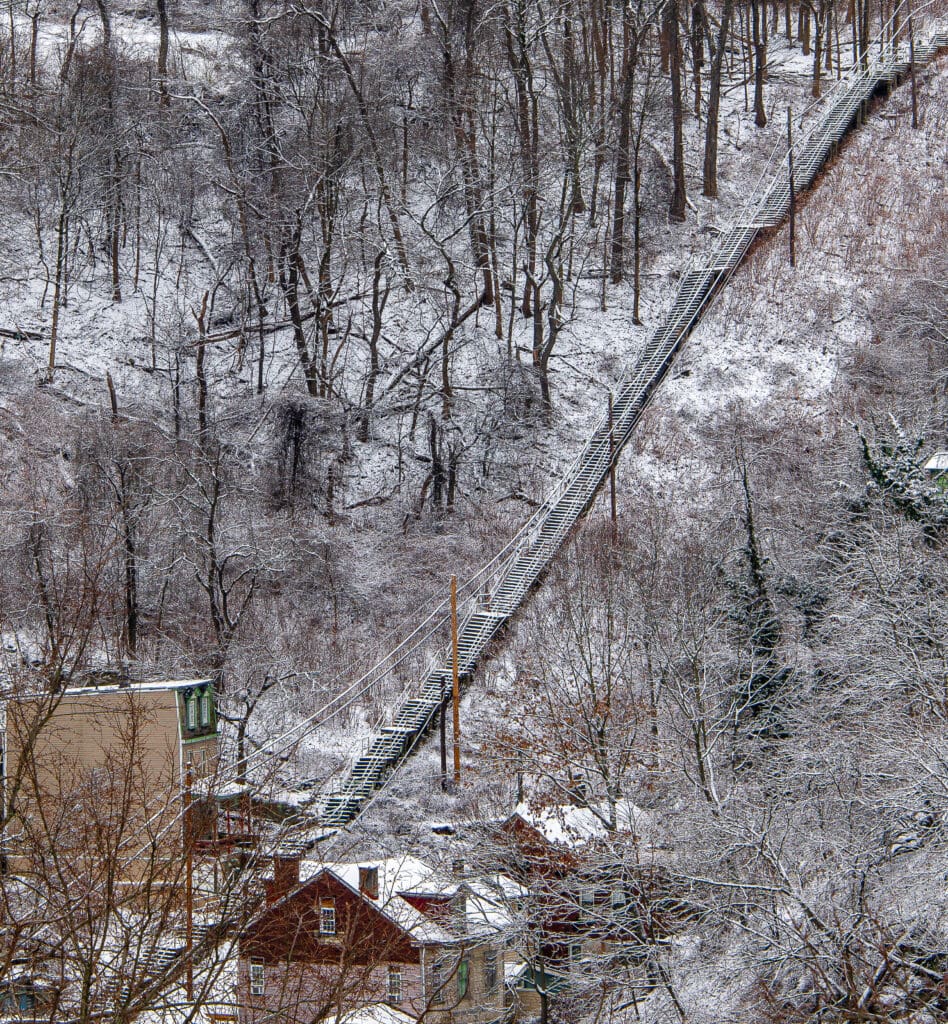
By Laura Zurowski
Pittsburgh’s public stairways are integral to the city’s history and a point of civic and neighborhood pride. They embody Pittsburgh’s history, romance, intrigue, and energy; their presence provides a uniqueness that sets it apart from other cities. These massive flights of concrete and steel offer visitors and locals a built-in way to travel between neighborhoods, exercise, and connect with others.
Pittsburgh, a city that was once home to a thriving population and large industrial complexes, developed its unique transportation system in the nineteenth and twentieth centuries. These public stairways, locally known as ‘city steps,’ were a necessity in a time when motor vehicles were not yet ubiquitous. They were a lifeline for many residents, enabling them to live within walking distance of the city’s major industries.
Pittsburgh First Mass Transportation System
As Pittsburgh’s population grew in the late 1800s, the need for reliable transportation systems became apparent. While omnibuses and trolleys were available, the fee to ride was often beyond what new arrivals and laborers could regularly afford. The city’s hilly terrain also posed a challenge, but the solution came in the form of public stairways. The city began constructing long flights of wooden stairways in the 1870s, and by 1937, over 13 miles were available, with more flights of city steps being constructed every year.
Boom, then Bust
As World War II ended, Pittsburgh City Council members and Mayor Cornelius D. Scully proactively started planning post-war infrastructure updates, including replacing nearly 100 flights of wooden city steps plagued by structural issues. Concrete stairs with steel railings were engineered and installed as they were more durable and had a life span ranging between 50 and 75 years. Throughout this time, newly constructed flights were often featured in local newspapers and celebrated by residents who marveled at their modern construction.
However, Pittsburgh’s glory days soon ended. Starting with the 1960 US Census, Pittsburgh’s population growth ended, and the era of double-digit depopulation began. Residents left the urban core for suburbs, and steel mills closed or relocated. As the city’s population declined from 700,000 to 300,000, Pittsburgh’s natural world aggressively reasserted itself into spaces no longer inhabited. Although structures and streets gradually disappeared, the city steps remained, maintaining a Zen-like presence in a post-apocalyptic landscape.

Going Green with City Steps
In 2014, looking for ways to help the city shed its “smokey” steel industry image, newly elected mayor Bill Peduto tasked city planners with conducting a citywide steps assessment to collect data and photos documenting each staircase’s location and condition. The city steps were part of Peduto’s plan to promote environmentally friendly transportation and provide mobility options for the 20 percent of residents without vehicles.
In 2017, the City Steps Plan was released. Through community meetings, field visits, and survey collections, quantitative and qualitative data helped determine what flights were critical for accessing public transportation, schools, grocery stores, hospitals, libraries, houses of worship, and main street business corridors. The plan helped systematize and prioritize the upkeep of city steps in areas with the greatest need.
The first of several large-scale city steps rebuilding projects was Joncaire Street in Central Oakland, near the University of Pittsburgh and Schenley Park. Completed in late 2018, the new stairs had a lower profile for easier climbing, closed railings and enhanced lighting for safety, an embedded bike runnel for cyclists, and stormwater and invasive species management features. Several newspapers, television and radio programs, and social media platforms covered the grand opening of the stairs. While construction styles and communications media had changed considerably since the late 1940s, local interest in the city steps was as enthusiastic as ever.
Exploring Pittsburgh through the City Steps
While the days of residents walking from “the hills to the mills” have disappeared into the past, the stairs have gained in popularity in the last several years. They offer an alternate form of public transportation and connect hikers and cyclists to a growing network of designated trails and bike lanes throughout the city.
Five Fun Facts About Pittsburgh’s City Steps
- Pittsburgh has over 900 flights of city steps scattered throughout the city’s 90 neighborhoods and 3,800 acres of parkland and greenway trails.
- The city’s hilly terrain means every flight is custom-designed and unique.
- 344 flights of stairs are legal streets, and many have specially designed street signs. In the early days of GPS systems, drivers were commonly misdirected to flights of stairs.
- Filmmaker Dean Bog’s The Best Urban Hiking is in Pittsburgh? provides a close-up view of city steps without lacing up your shoes.
- The Western Pennsylvania Regional Data Center’s City of Pittsburgh Steps and the Pittsburgh City Steps Facebook group provide details and encouragement for creating your own city steps adventure.
Laura Zurowski is the creator of Mis.Steps: Our Missed Connections with Pittsburgh’s City Steps and co-author of City Steps of Pittsburgh: A History & Guide (The History Press, 2024).
Color photos by Matthew Jacob
Historic photo of the Indian Trail stairs courtesy of the Pittsburgh City Photographer Collection, 1901-2002, AIS.1971.05, Archives & Special Collections, University of Pittsburgh Library System.